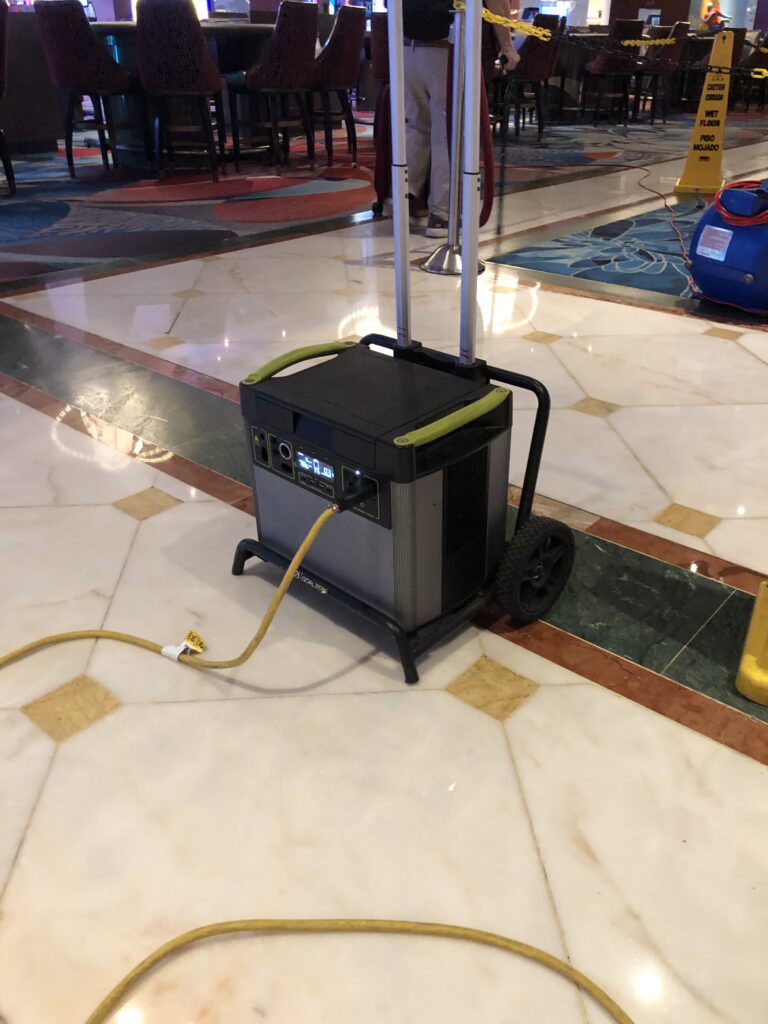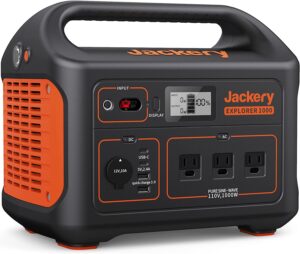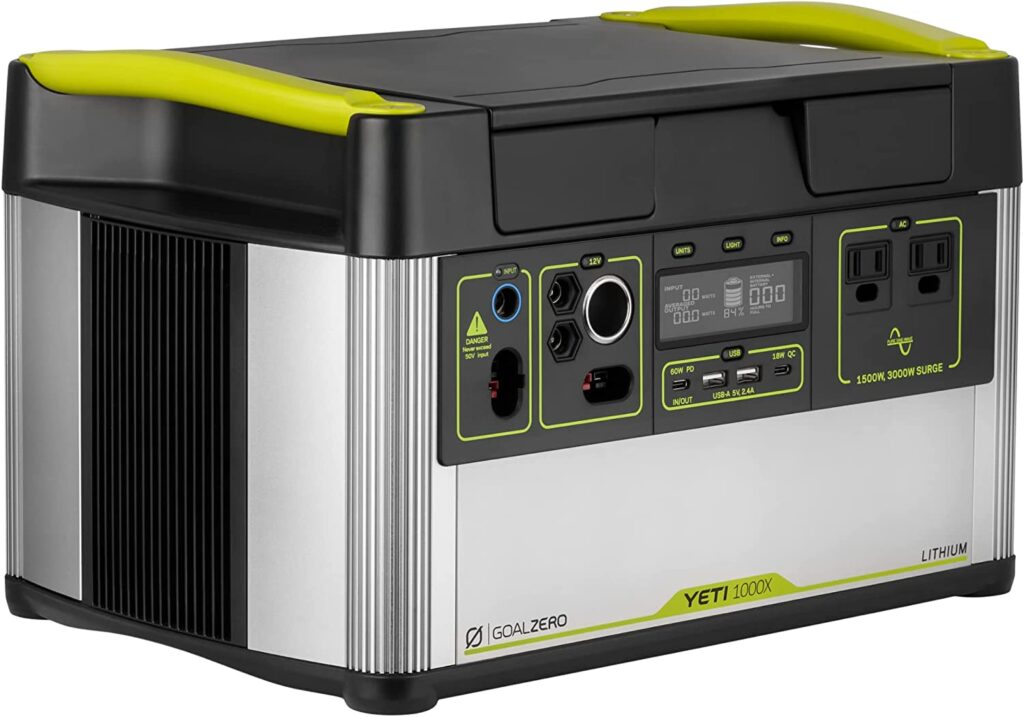After further review….
I’ve trash-talked “solar generators” before. Besides having a dumb marketing department name, solar generators are underpowered for what they cost. Furthermore, the claims made by some sellers of these devices are fantasy if not outright fraudulent.
At least that’s how it used to be. Lately, after further research and hearing from Off Grid Ham readers, I’ve softened my position on solar generators. Yeah, I still have some misgivings, but I’m starting to see at least some limited value to these devices. What changed? What happened?
That was then, this is now.
Technology and economies of scale, that’s what happened. As the technology improved and manufacturers rolled out more products, the cost came down. Mind you, these are still pricey devices. But compared to just a few years ago, things are looking better.
Solar generators are becoming more mainstream. Last summer when I was on vacation in Las Vegas, Nevada, the maintenance crew at the resort I was staying at was using several portable battery power units to operate industrial carpet cleaning machines and large fans. I assume they were using portable power because it was easier and safer than stretching extension cords a long distance across a casino floor. I estimate the floor cleaner pulled 15 amps, maybe a little more. It was an impressive and practical use of battery power.

Goal Zero device being used to power an industrial carpet cleaner at a casino in Las Vegas, Nevada. OFFGRIDHAM.COM ORIGINAL PHOTO ©2022
So, it’s clear that solar generators are no longer gimmicky, obscure devices for hobbyists, outdoorsmen, and technogeeks.
For this analysis we will examine two similar solar generators from two different manufacturers, Jackery and Goal Zero. I chose these two because both are very well known names you’ve probably heard before and are readily available in the United States.
Jackery.
The Jackery Explorer 1000 has a 46 amp-hour lithium battery, a built in MPPT solar charge controller, a full sine wave inverter, a status meter, and a variety of DC outputs including USB ports. You also get an AC charger and car charger. At face value, it’s a pretty neat package. What can we reveal by picking this one apart?
For starters, there’s the $1099.00 USD price tag. At this price, your “solar generator” does not include a solar panel. A 100 watt solar panel will run an additional $299.00 USD, and they recommend you have two of them. So, to make your solar generator generate anything, you’ll have to add $598.00 USD to the $1099.00 base cost. For those keeping score, we’re up to $1697.00 USD for a fully operational off grid device.
The manufacturer data sheet states that the battery will charge 0%-80% from the AC adapter in 7 hours, 200 watts of solar in 8 hours, and the car charger in 14 hours. These are long charge times; the car charger is essentially useless. Add more solar panels to reduce solar charge times.
Goal Zero.
The Goal Zero Yeti 1000X has a retail price of $1299.95 USD. It has the same output options and similar capacity battery as Jackery. An AC charger is included. Goal zero describes their products as “power stations” that can be turned into “solar generators” by adding an optional solar panel. They offer several sizes of solar panels; the 200 watt folding panel is $549.00 USD (larger panels are available). The entire package with solar panel will cost $1848.95 USD.
The claimed charge times are: Wall charger (120 watt) 9 hours; Boulder 200 solar panel 6-12 hours. These charge times are unacceptably long. Goal Zero offers a more powerful 600 watt AC charger for $199.95 and larger capacity solar panels too, but heck, we’re already over $1800.00 USD for this basic setup.
Keep in mind that the solar charge times assume you have strong, continuous sun on the panels for the entire charge cycle.
Comparing apples to apples.
It’s important to point out that the Jackery battery is 21.6 volts and the Goal Zero battery is 10.8 volts. Although the Goal Zero battery has twice as many amp-hours as the Jackery, it also has half the voltage. To keep the comparison accurate, I went by the watt-hours, which are very similar (1002 Wh for Jackery and 983 Wh for Goal Zero). When doing your own research, make sure you are accounting for any differences in battery voltage.
Battery pedigree.
While we’re talking about batteries, not all lithium batteries are the same. Well known names like Panasonic, Sony, Mitsubishi, and others are batteries one can have confidence in. Smaller niche manufacturers such as Bioenno and Dakota Lithium also make very high quality batteries.
The market is flooded with batteries made by a variety of little-known manufacturers of unknown reputation. None of the solar generators I researched for this article specified the brand and origin of the battery. You don’t really know what you’re getting.
I sent emails to both Jackery and Goal Zero inquiring exactly what brand of batteries are used in their products. I was surprised to get a quick response from both. Here are their verbatim replies:
From Jackery: “Hello Chris, I am sorry for the delayed response due to many recent consultations. Your understanding is much appreciated. The Jackery products are Manufactured in China and designed in California-US. The Batteries are Li-ion NMC ( Nickel manganese cobalt ). Thanks for your waiting and patience.”
From Goal Zero: “Hello, Thank you for contacting Goal Zero! We do not have a specific brand that we use as they are custom Lithium Ion batteries that we use. But that is all the information that I would be able to provide.”
You can draw your own conclusions from these meaningless non-answers. Lastly, when contacting them I did not identify myself as a blogger or “influencer”. Jackery did send a follow-up email a few days later asking if my “issue had been resolved”. I didn’t have any additional questions, but I appreciated the effort.
Playing lawyer.
Jackery offers a two year warranty, but the warranty does not include units purchased through an “online auction house” (not clear if this includes Amazon), and more strikingly, the warranty does not cover the battery itself unless you fully charge it within seven days of delivery and then at least every six months after that. How you would prove you followed these instructions is lost on me.
Goal Zero offers the same 2 year warranty, with the same “auction house” and battery exclusions. Furthermore, open-box items are warranted for only six months.
Build vs. buy.
Until now, a valid argument against solar generators was that you could build one cheaper than you can buy one. However not everyone can or wants to build their own equipment. Many people, for whatever the reason, want a plug-and-play solution and are willing to pay for it. You can still save money by going the DIY route, but that argument is getting thinner as commercially made units become more affordable.
Saving money notwithstanding, a big advantage to building your own equipment is that you can hand-pick everything that goes into it. There’s no need to settle for what someone else thinks is good enough. For many hams, and I place myself in this category, having purpose-built equipment made to your own standards is a very high priority.
You do not have to use solar panels sold by the same manufacturer that makes your generator. Even if you decide to buy a ready-to-go unit, It might be worthwhile to shop around and find less expensive panels elsewhere.
So are “solar generators” worth having?
The short answer is yes. I reverse my previous position. The long answer is yes, but there are a lot of serious caveats; any potential user of solar generators should go into this only after thoroughly understanding the details.
Here’s some of the issues you should very carefully consider before you plop down your hard-earned money:
- Your “solar generator” will likely not include a solar panel.
- You do not have to buy “their” solar panels. Look for a better deal elsewhere.
- The brand and quality of the batteries is unknown—this is a big one.
- Read the warranty carefully and be aware of significant exclusions.
- The charge times can vary greatly and in some cases are unacceptably long.
- The best way to get exactly what you want is to build your own.
- Be aware that some of the claims made by manufacturers regarding battery run times and power capacity are grossly exaggerated.
I’m still not a huge fan of “solar generators”. I will concede that for some hams, they are a reasonable solution. Shop carefully, do your homework, and you’ll be very satisfied with your decision.
What are your experiences with solar generators? Tell us in the comment section below.


I like the idea of solar generators but the price is a bit much when one can be built much cheaper. I have yet the build one. I still have all the different parts that I have to assemble on site to have the same results. I also bring extra cables and splitters in case I lose one. Would a solar generator be of simple, good use? Yes. Am I going to buy one? no yet, Though I have thought about it several times. One other thing is the wieght of a solar generator. As an old guy I can pick up and carry all the parts. I picked of a friends solar generator and all most didn’t get it from the truck to the table. (That dang thing was heavy.)
Hey there, Jed. I hope you’re doing well. It is certainly more cost effective to build your own. For those of us who have been doing this a long time and have collected a variety of extra equipment, we may already have some of what we need to put one together.
Yet, as part of my semi-reversal I understand that not everyone has the skill, resources or desire to build a solar generator. For those folks, buying one is a reasonable, albeit costly, option.
Regarding your issue of the generator being too heavy: There is no requirement that all the components be in the same box. Consider building a modular system where each part can be transported separately. That is the benefit of building your own…you can create something that suits your particular needs.
Good article, good subject . With many options available
These days a little straight talk helps, de wb5eat
I appreciate you confidence, Bob. Off Grid Ham does not have sponsors or affiliates. I carry water for no one. What you read on this website are my own unfiltered, independent observations.
I’m interested in going “off grid” (mostly because of the XYL, she claims I DOUBLED the electric bill since getting licensed) and so far, the cheapest solar setup I’ve found was STLL about $600!!
Maybe when I win the lottery…
Hi there Phil, if money is an issue (and for nearly all of us it is) consider building the Off Grid Ham 100 Watts For $300 solar project. It’s the most popular DIY article on this website and many readers have built successful devices based on my concept. It does not involve a lithium battery, but you could build a lithium version for less than the $600 you’re looking at now.
Thanks! I’ll check it out!!!!
Another great post! Was always curious about those, I have a better understanding now. Thanks for time you put into your blog!
I’m glad I could supply some insight. Thanks for bing an Off Grid Ham reader. You can further support this website by passing the word along, posting on social media, etc. Thanks again!
Your article on solar generators was great. I have built my own with solar panels, charge controllers, and inverters that I have accumulated over time. I would love to have the portability of a solar generator. I was wondering about EcoFlo.
Hi Richard, I don’t know about EcoFlo or any other particular brand. Off Grid Ham is not a review site and does not have sponsors or affiliates. That means what you do read here is honest and without external influences.
It sounds like you already have the ingredients for an effective portable generator. All you need to do is find a way to package it up for transport.
My main objections to these things have been A) the misleading and often blatantly false advertising I’ve seen for these things which makes it difficult for the average person to determine what they are actually getting. B) The cost. And C), as you found out it’s almost impossible to find out who actually makes the batteries in these things which is important because of safety concerns.
That being said I do have one, although a small one. I picked that up along with a matching folding solar panel on a closeout sale on Woot!. It’s from Rocksolar and I have to admit it’s pretty nice for what it is. It can run my FT-818 all day long (which was the real reason I was interested in it). It has an AC inverter but that can only handle 200 watts max so it can’t handle the most essential appliance in the house, my coffee maker 🙁 But my son borrows it when he goes camping and it’s fine for providing light, charging his phone, etc.
One I was looking at rather seriously was the Bluetti system. 2,200 Watt hour capacity, can handle up to 30 Amp, expandable up to 8,300 WH with additional battery packs, etc. That’s close to being a whole house power system. It would be a more or less “turnkey” system (except for charging), hooked up as a emergency power system to run the essential systems during power outages, etc.
Two issues. First is cost. It is freaking expensive. The base unit is about $2,000, with the additional batteries adding another couple of grand to the cost.
Second is charging, that price doesn’t include the solar panels, of course. Enough solar capacity to charge it in a reasonable amount of time would add a grand or two to the cost.
There are tradeoffs with all of these systems, whether gasoline, natural gas, propane powered or solar/battery combinations.
FYI: I also looked into the Tesla solar roof/power wall system. It’s an interesting system but the prices would make your eyes water. At the time a system adequate to handle the essential systems in the house would have cost about $40,000. I suspect that would be considerably higher today.
I suspect I’ll end up getting something like the Bluetti or the equivalent just for convenience sake eventually. the issue is going to be charging the darned thing, especially during the winter months when we can go for literally weeks with dense cloud cover.
Hi Randall, I’m really grateful for your ongoing support and engaging comments. I hope you’re doing well.
As you have found out (and was the focus of this article) trying to sort these things out is darn near impossible. My biggest concern is the batteries. Not knowing the brand/origin of the batteries is a big negative for me. And you are also right about the fantastic claims the manufactures make about the power capacity of their solar generators. One of the goals of Off Grid Ham is to educate readers and give them the knowledge they need to make informed decisions.
The cost of solar generators is still a huge roadblock for many people. One of my neighbors came to me for advice after he looked into getting a solar generator and determined that it would cost about $5000 for a system that would suit his needs. I had the unfortunate task of telling him yeah, that’s what it will take to buy a plug-and-play system. Sorry. He hasn’t made a decision yet but unfortunately that is the reality that must be faced if one is not willing/able to undertake a DIY project. And even when you are willing to DIY it, it can still be very costly.
Once again, thanks so much for your support and enthusiasm.
These batteries are becoming a serious issue. I have an e-bike now so I’ve been keeping an eye on that market for a while and there is a major problem with some of the cheap models, especially the ones used for delivery vehicles in cities, starting on fire. The well made batteries are safe but some of the ones coming out of China can be ticking time bombs. So I definitely agree with you that knowing where the battery cells are sourced from is important.
My main interest in these generators isn’t the ability to charge them from solar panels, it’s the ease of use. I’m concerned with how my wife would handle a blackout if I weren’t around because there’s no way she could get the big Generac started by herself, especially in winter. I need to have a system that’s simple to use and that can keep the furnace and sump pumps going for at least several hours.
Here in Michigan, “winter” is defined by the lack of sunshine!!! If it’s sunny, it’s sub zero out!!!
I’m a little skeptical of running any serious AC current from any of these devices.
I found this video ( https://www.youtube.com/watch?v=bPgFrf7LXjA ~ starting right around the 2:12 ) after I purchased my Allpowers unit. Notice how the AC wires uses a quick disconnect paired with what looks like 16-20 awg wiring to the outlets.
Hi Jeff, I looked at the video. It’s hard to tell for sure but that looks like 16 gauge wire. That size wire is commonly used in low current AC applications, such as lamp cords, battery chargers for consumer electronics, small fans, etc. Considering a unit such as the one in the video cannot likely produce much current anyway, it’s probably ok.
Thanks for your comment. I hope you’ll stop by again soon.